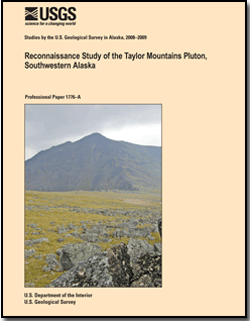U.S. Geological Survey Professional Paper 1776–A
ABSTRACT
The Taylor Mountains pluton is a Late Cretaceous to early Tertiary (median age 65±2 Ma) epizonal, composite biotite granite stock located about 235 km (145 mi) northeast of Dillingham in southwestern Alaska. This 30 km2 (12 mi2) pluton has sharp and discordant contacts with hornfels that developed in Upper Cretaceous clastic sedimentary rocks of the Kuskokwim Group. The three intrusive phases in the Taylor Mountains pluton, in order of emplacement, are (1) porphyritic granite containing large K-feldspar phenocrysts in a coarse-grained groundmass, (2) porphyritic granite containing large K-feldspar and smaller, but still coarse, plagioclase, quartz, and biotite phenocrysts in a fine-grained groundmass, and (3) fine-grained, leucocratic, equigranular granite. The porphyritic granites have different emplacement histories, but similar compositions; averages are 69.43 percent SiO2, 1.62 percent CaO, 5.23 percent FeO+MgO, 3.11 percent Na2O, and 4.50 percent K2O. The fine-grained, equigranular granite is distinctly felsic compared to porphyritic granite; it averages 75.3 percent SiO2, 0.49 percent CaO, 1.52 percent FeO+MgO, 3.31 percent Na2O, and 4.87 percent K2O. Many trace elements including Ni, Cr, Sc, V, Ba, Sr, Zr, Y, Nb, La, Ce, Th, and Nd are strongly depleted in fine-grained equigranular granite. Trace elements are not highly enriched in any of the granites. Known hydrothermal alteration is limited to one tourmaline-quartz replacement zone in porphyritic granite. Mineral deposits in the Taylor Mountains area are primarily placer gold (plus wolframite, cassiterite, and cinnabar); sources for these likely include scattered veins in hornfels peripheral to the Taylor Mountain pluton. The granite magmas that formed the Taylor Mountains pluton are thought to represent melted continental crust that possibly formed in response to high heat flow in the waning stage of Late Cretaceous subduction beneath interior Alaska. |
For additional information contact: This report is presented in Portable Document Format (PDF); the latest version of Adobe Reader or similar software is required to view it. Download the latest version of Adobe Reader, free of charge. |
Hudson, T.L., Miller, M.L., Klimasauskas, E.P., and Layer, P.W., 2010, Reconnaissance study of the Taylor Mountains pluton, southwestern Alaska, in Dumoulin, J.A., and Galloway, J.P., eds., Studies by the U.S. Geological Survey in Alaska, 2008-2009: U.S. Geological Survey Professional Paper 1776-A, 13 p.
Abstract
Introduction
Taylor Mountains Pluton
Chemistry
Age of the Taylor Mountains Pluton
Mineral Occurrences
Discussion
Conclusion
References Cited
Appendix—Summary of Analytical Method for 40Ar/39Ar Analysis